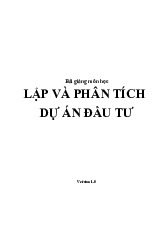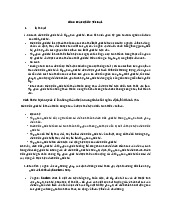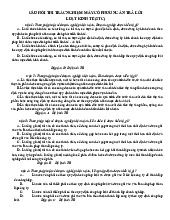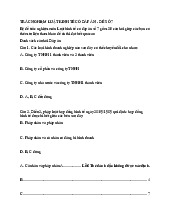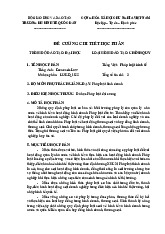










Preview text:
lOMoARcPSD| 38777299
NATIONAL ECONOMICS UNIVERSITY
SCHOOL OF ADVANCED EDUCATION PROGRAMS -------***-------
INTRODUCTION TO BUSINESS LAW Contracts and Sales:
Introduction and Formation : TABLE OF CONTENTS
PART 1. THEORIES OF CONTRACT....................................................................................3 I. Definition of a
Contract................................................................................................3 II.
Sources of Contract Law...........................................................................................3 III.
Types of Contracts....................................................................................................3 IV.
Formation of Contracts.............................................................................................3
PART 2. CASE STUDY...........................................................................................................4 I.
Facts:........................................................................................................................... 4 II.
Issues........................................................................................................................5 III.
Rules........................................................................................................................5
3.1. Precedent: “CRAFT v. ELDER & JOHNSTON CO.Court of Appeals of Ohio, Montgomery
County, 1941. 38 N.E.2d 416.”............................................................................................5
3.2. Formation of Contracts..............................................................................................7
IV. Judicial decision & analysis.......................................................................................7 lOMoARcPSD| 38777299
V. The decision of common pleas court of appeals.................................................................8
PART 3. APPLICATION IN VIETNAM..................................................................................8
PART 4. LESSONS LEANRNED...........................................................................................11
PART 1. THEORIES OF CONTRACT I.
Definition of a Contract
Contract is a promise or set of promises for breach of which the law gives a
remedy, or the performance of which the law in some way recognizes as a duty. II.
Sources of Contract Law 1. Common Law
Common law today consists of traditional notions of law developed by judical
decisions and often codified by states.
2. The Uniform Commercial Code (UCC)
UCC is formed by a set of commercial laws that all states would find acceptible. III. Types of Contracts
1. Bilateral versus Unilateral Contracts
Bilateral contract: is a contract in which both parties promise to perform certain things.
Unilateral contract: has one party issuing a promise and the other party simply performing.
2. Express versus Implied Contracts
Express contract: A contract that is written or orally agreed to.
Implied contract: Arises from circumstances and not from the express agreement
of the parties. In this situation, the parties do not discuss the terms of the contract
but nonetheless understand that they have some form of contractual relationship.
There are several types of contracts that are required to be in writing and cannot be formed by verbal agreement • Real estate contracts
• Contracts that cannot be performed within one year
• Contracts for the sale of goods over a certain value
• Contracts involving the transfer of property or assets
• Contracts for loans or credit
• Contracts that involve marriage IV. Formation of Contracts
There are several elements that must be present for a valid contract to be formed, including: lOMoARcPSD| 38777299
• Offer: One party must make a clear and specific offer to enter into a contract with another party.
• Acceptance: The other party must accept the offer made by the first party,
and this acceptance must be communicated in a way that is clear and unambiguous.
• Consideration: Both parties must exchange something of value, such as
goods, services, or money, as part of the contract.
• Intent: Both parties must have a genuine intent to create a legally binding agreement.
• Capacity: Both parties must have the legal capacity to enter into a contract,
meaning they are not under duress, incapacitated, or otherwise unable to make a binding agreement. PART 2. CASE STUDY I. Facts:
Name of the case: Alligood v. Procter & Gamble Co.
Judicial Proceeding: Court of Appeals of Ohio, First District, Hamilton County;
Appeal from the Court of Common Pleas, Hamilton County. Decided January 30, 1991
Plaintiff: Ms.Alligood and other purchasers
Defendant: Procter & Gamble Co.
Procter & Gamble Co., a producing branded consumer products company,
began a Pampers catalog promotional offer in 1981. A statement on each box of
Pampers explained that by saving the teddy bear proof-of-purchase symbols
(Teddy Bears points) on packages of Pampers diapers, a customer could order
various baby items from the Pampers Softouches Baby Catalog at a reduced
cost. The catalog would be sent free to consumers upon request. Included in the
catalog were pictures of the items for sale and the designated amount of Teddy
Bears points and cash necessary for purchase. All sale terms, including the
dates during which the offer was in effect, were described in each catalog. The lOMoAR cPSD| 38777299
only method for ordering merchandise was the use of the specific order form included in each catalog.
About April 1989, P&G sent out its final catalog. On the front of the catalog
was a statement that it was the final catalog and that the offer would expire on February 28, 1990.
Ms. Alligood and others had cut out and saved the teddy bear symbols. The
diaper purchasers claim that each package of Pampers contained an offer to
enter into a unilateral contract, which they accepted by purchasing Pampers and
saving the teddy bear proof-of-purchase symbols.
The precise language of the advertisement printed on packages of Pampers states as follows:
"Save these Teddy Bears points and use them to save money on toys, clothes,
furniture, and lots of other baby things when you shop the Pampers Baby
Catalog. For your free copy of the Catalog, send your name, complete address,
and youngest baby's date of birth to: "Pampers Baby Catalog "P.O. Box 8634, "Clinton, Iowa 52736."
On May 1, 1989, two groups of plaintiffs filed separate complaints against
defendant-appellee, the Procter & Gamble Company (“P&G”), alleging breach
of contract arising from a catalog of Pampers diapers. The plaintiffs-appellants
sought class-action certification and representation, which was granted on Jun
7, 1989. On June 16 and June 29, 1989, P&G filed motions to dismiss,
requesting that they be treated as motions for summary judgment. Following
oral argument, the Court of common pleas granted summary judgment to P&G on October 30, 1989.
Ms.Alligood and other purchasers of disposable diapers (plaintiff) brought a
breach of contract action against manufacturer based on failure to redeem proof
of purchase symbols for merchandise. The Court of Common Pleas, Hamilton
County, entered judgment in favor of manufacturer, and purchasers appealed. lOMoARcPSD| 38777299 II. Issues
Whether an enforceable contract existed between the plaintiffs and P&G based on
the language on the Pampers packages? III. Rules
3.1. Precedent: “CRAFT v. ELDER & JOHNSTON CO.Court
of Appeals of Ohio, Montgomery County, 1941. 38 N.E.2d 416.” - Plaintiff: Craft
- Defendant: Elder & Johnston Co.
On or about January 31, 1940, the defendant, the Elder & Johnston Company, carried
an advertisement in the Dayton Shopping News, an offer for sale of a certain all
electric sewing machine for the sum of $26 as a “Thursday Only Special”.
Plaintiff in her petition, after certain formal allegations, sets out the substance of the
above advertisement carried by defendant in the Dayton Shopping News. She further
alleges that the above publication is an advertising paper distributed in Montgomery
County and throughout the city of Dayton; that on Thursday, February 1, 1940, she
tendered to the defendant company $26 in payment for one of the machines offered
in the advertisement, but that defendant refused to fulfill the offer and has continued
to so refuse. The petition further alleges that the value of the machine offered was
$175 and she asks damages in the sum of $149 plus interest from February 1, 1940.
The trial court dismissed plaintiff’s petition as evidenced: “Upon consideration the
court finds that said advertisement was not an offer which could be accepted by
plaintiff to form a contract, and this case is therefore dismissed with prejudice to a
new action, at costs of plaintiff.” Within statutory time plaintiff filed notice of appeal on questions of law.
According to the determination of Court of Appeals of Ohio, the court also affirmed
and concluded that they constrained to the view that the trial court committed no
prejudicial error in dismissing plaintiff’s petition. The judgment of the trial court
will be affirmed and costs adjudged against the plaintiff-appellant. In the decision
making process, the rule was well established. “It is clear that in the absence of
special circumstances an ordinary newspaper advertisement is not an offer, but is an
offer to negotiate, an offer to receive offers or, as it is sometimes called, an offer to
chaffer.” Restatement of the Law of Contracts, Par. 25, Page 31.“Thus, if goods are
advertised for sale at a certain price, it is not an offer and no contract is formed by
the statement of an intending purchaser that he will take a specified quantity of the
goods at that price. The construction is rather favored that such an advertisement is lOMoARcPSD| 38777299
a mere invitation to enter into a bargain rather than an offer. So a published price list
is not an offer to sell the goods listed at the published price.” Williston on Contracts,
Revised Edition, Vol. 1, Par. 27, Page 54. “The commonest example of offers meant
to open negotiations and to call forth offers in the technical sense are advertisements,
circulars and trade letters sent out by business houses. While it is possible that the
offers made by such means may be in such form as to become contracts, they are
often merely expressions of a willingness to negotiate.” Page on the Law of
Contracts, 2d Ed., Vol. 1, Page 112, Par. 84. “Business advertisements published in
newspapers and circulars sent out by mail or distributed by hand stating that the
advertiser has a certain quantity or quality of goods which he wants to dispose of at
certain prices, are not offers which become contracts as soon as any person to whose
notice they may come signifies his acceptance by notifying the other that he will take
a certain quantity of them. They are merely invitations to all persons who may read
them that the advertiser is ready to receive offers for the goods at the price stated.” Corpus Juris 289, Par. 97.
3.2. Formation of Contracts 3.2.1. Offer
To be valid, an offer must contain certain and definite language and cover all
necessary terms, which include the following: ➢ Parties
➢ Subject matter of the contract ➢ Price
➢ Payment terms ➢ Delivery terms ➢ Performance times 3.2.2. Consideration
Consideration is what distinguishes gifts from contracts and is what each party give
up under the contract. It is sometimes called Bargained-for-exchange. As
consideration is one of the three main requirements of forming a contract, in order
to create a legally valid contract, the parties will need to exchange something of value. IV.
Judicial decision & analysis
Our main case Alligood v. Procter & Gamble Co. would be analyzed based on the
general rule of contract formation and being supported by the rule which was
established from the precedent. lOMoARcPSD| 38777299
Firstly, a valid offer must have key phrases including the identity of the parties to
be bound, the contract's subject matter, price term, due time, conditions of payment
and delivery. Clearly, the phrase displayed on Pampers boxes, which Ms. Alligood
and others claim constitutes the whole unilateral contract with P&G, falls well
short of all the elements for a legitimate contract. It states: "Save these Teddy
Bears points and use them to save money on toys, clothes, furniture, and lots of
other baby things when you shop the Pampers Baby Catalog”. We can see that
only one of the parties, P&G, can be identifiable. The commercial itself made no
mention of the steps a potential offeree would be required to take to accept the
discounts on other products. The supposed contract's subject matter, as well as the
offeree's necessary consideration, are both unclear enough to be noticed. No
pricing or delivery terms are stated in the advertisement.
Consideration is also too vague to be discernible. Essentially, if there is a
consideration between the two parties, the supplier offers an incentive such as
discount points in exchange for increased sales, while the offeree must make a
purchase in order to receive the discount. However, how those points are redeemed
for discounts is not stated clearly. Hence, the advertisement and catalog as a whole
would not represent a single contract.
Secondly, according to the rule which was established from the precedent, ads are
simply invitations for offers. Even if advertisements offering to redeem proof of
purchase symbols with merchandise from catalogue were taken in conjunction
with the catalog, and even if the catalog's expiry date had not passed, there would
not have been an offer to enter into a contract. Advertisement and catalogue would
create only an offer to receive offer, and an invitation to order from the catalog. As
a result, there are no legal commitments for which P&G can be held liable.
V. The decision of common pleas court of appeals
The judgement was affirmed. P&G is not at fault for refusing to redeem the Teddy
Bears points and that the purchasers lack contractual rights to compel P&G to deliver the catalog products.
PART 3. APPLICATION IN VIETNAM
Due to the absence of similar case law in Vietnam, we request permission to use
Vietnamese laws to support the practical application in Vietnam. lOMoAR cPSD| 38777299
According to Article 14 of the CISG, "A proposal for concluding a contract
addressed to one or more specific persons constitutes an offer if it is sufficiently
definite and indicates the intention of the offeror to be bound in case of
acceptance. A proposal is sufficiently definite if it indicates the goods and
expressly or implicitly fixes or makes provision for determining the quantity and
the price." Article 14 of the CISG provides a definition of an offer to contract,
forming an offer when it is sent to one or more identified persons, expressing the
offeror's intention to be bound upon acceptance, and providing criteria for
determining the essential content of an offer to contract. Therefore, Procter &
Gamble's reward program, as advertised, clearly demonstrates the intention to enter into a contract.
Therefore, P&G unilaterally made an offer. According to Section 1, Artical 390 of
the 2005 Civil Code, "An offer to contract is the expression of the offeror's
intention to conclude a contract and the offeror's commitment to this offer towards
the specific offeree." Compared to this provision, Section 1, Artical 386 of the
2015 Civil Code has removed the phrase "specific": "An offer to contract is the
expression of the offeror's intention to conclude a contract and the offeror's
commitment to this offer towards the offeree or the public." The 2015 Civil Code
recognizes the clear expression of intention to contract and the binding nature of
this offer on the offeror towards the "public," making the offer to contract closer to
a notification, an advertisement sent to an unspecified target, whether an individual or a specific organization.
Regarding the service contract, the acceptance of the offer to contract can be
demonstrated through conduct, such as when the promisee is rewarded for
performing actions requested by the promisor, without the need to provide a verbal
acceptance. Alligood accepted the offer to contract from the moment the request to receive the catalog was sent.
Furthermore, Vietnamese law does not regulate consideration in contract
formation. Therefore, the contract has been formed. According to Article 386 of
the 2015 Civil Code, two types of entities are proposed: specifically identified
entities or the public. This serves as a basis for determining the offer to contract by
individuals or businesses through flyers, mass media, mobile phones, or email
addresses if the advertising content contains indications of an offer to contract, the
organization or individual making the offer must be responsible for the committed content.
US law approaches the issue differently, allowing the offeror to actively modify or
withdraw the initial offer at any time if the offeree has not yet responded to accept, lOMoARcPSD| 38777299
and the offeror is not bound by any contractual obligation. Even if the offer to
contract sets a final deadline for the offeree's response, any notification of changes
or withdrawal remains effective until the end of this period. If the offeror clearly
expresses the intention not to enter into the contract and the other party agrees, the
two parties are not considered to have entered into a contract, thus no legal liability
arises for the offeror, as in Vietnamese law. The source of US law is primarily case
law based on practical principles rather than assumptions of reality, ensuring the
right to modify or withdraw offers, and maintaining a balanced intention for both
parties. Artical 42 of the Compilation of US Contract Law states: The right of
acceptance of the offeree terminates when this party receives from the offeror an
indication of the intention not to enter into the proposed contract.
However, in the event of a lawsuit in Vietnam, according to the provisions of the
Civil Code 2015, both advertising and bidding are considered offers. Therefore,
under Article 386 of the Civil Code 2015, the organization or individual that made
the offer is responsible for the content committed. Based on the aforementioned
legal provisions, we can conclude that Alligood will be the winning party as P&G
has breached the promised reward contract.
PART 4. LESSONS LEANRNED
The case of Alligood v. Procter & Gamble Co. teaches us several important lessons
about the legal requirements for a valid contract and the consequences of failing to meet these requirements.
Firstly, the case emphasizes the importance of mutual assent, or a meeting of the
minds, in creating a valid contract. Both parties must clearly and unequivocally
agree to the terms of the contract in order for it to be enforceable. In the case of
Alligood v. Procter & Gamble Co., the court found that there was no clear and
mutual agreement between the parties, as the terms of the promotional offer were
not sufficiently clear and definite.
Secondly, the case highlights the importance of definiteness of terms in creating a
valid contract. The terms of the contract must be specific and definite enough to
allow the parties to understand and fulfill their obligations. In the case of Alligood
v. Procter & Gamble Co., the court found that the terms of the promotional offer
were not clear and definite enough to create an enforceable obligation.
Thirdly, the case underscores the importance of consideration in creating a valid
contract. Both parties must exchange something of value in order for the contract
to be enforceable. In the case of Alligood v. Procter & Gamble Co., the court lOMoARcPSD| 38777299
found that the plaintiffs had not provided any consideration in exchange for the
promotional offer, as the purchase of Pampers diapers alone was not sufficient consideration.
Fourthly, the case demonstrates the importance of reading and understanding the
terms of an offer before accepting it. Failure to do so can result in a lack of
contractual rights, as in the case of Alligood v. Procter & Gamble Co.
Finally, the case highlights the concept of summary judgment, which allows a
judge to rule on a case without a trial when there is no genuine dispute of material
fact. Summary judgment can be a powerful tool for resolving legal disputes
quickly and efficiently, but it requires careful consideration of the facts and legal arguments in the case.
The lessons learned from this case are that to have an enforceable contract, there
must be a meeting of the minds1 of the parties to the contract, and a valid contract
must also be specific as to its essential terms, such as the identity of the parties to
be bound, the subject matter of the contract, consideration, a quantity term, and a
price term. By understanding these requirements and taking care to ensure that
contracts are clear, definite, and mutually agreed upon, individuals and businesses
can avoid costly legal disputes and protect their rights under the law. REFERENCES
1. Curiam., P. (1991) Alligood v. Procter Gamble Co.., Legal research tools
from Casetext. Available at: https://casetext.com/case/alligood-v-
proctergamble-co (Accessed: May 7, 2023).
2. Institute of Law. (n.d.). LAW100F-Week02b.pdf [Course handout].
Retrieved from https://instituteoflaw.com/Preview/Law100-2b/law100f- week02b.pdf
3. Jennings, M. M. (2019). Foundations of the legal environment of business (3rd ed.). Cengage Learning.
4. Luật Minh Khuê. (2022) "Đề nghị giao kết hợp đồng và chấp thuận đề nghị
giao kết hợp đồng". Available at: https://luatminhkhue.vn/de-nghi-giao-
kethop-dong-va-chap-thuan-de-nghi-giao-ket-hop-dong.aspx
5. Nguyễn Thị Diễm Hường – Hoàng Như Thái. (2018) "Điểm Hướng - Vấn
đề về đề nghị giao kết hợp đồng" Bách Khoa Đại học Bùi Thị Xuân. Available at:
1 Meeting of the minds: a situation in which two or more people reach an understanding or agreemnet lOMoARcPSD| 38777299
http://lib.bvu.edu.vn/bitstream/TVDHBRVT/19057/1/DiemHuong.pdf? fbclid=IwAR33AE-
TEgqjR1kBNbrXF_tBHG6aO7qVBz4pewBAhgW42yJURl1a7Kh_HG8
6. ThS. Mai Thị Mai Hương – ThS. Hoàng Thị Thanh Nguyệt. (2019) "Quy
định về giao dịch dân sự trong Bộ luật Dân sự 2015". Available at:
https://tapchicongthuong.vn/bai-viet/cac-quy-dinh-phap-luat-ve-giao-
kethop-dong-nhin-tu-goc-do-luat-hoc-so-sanh-67036.htm? fbclid=IwAR07v3xsXCYJTqD-
Tth7xa6w9w85htIPyf55iDw9xX5sQbANSCKO3YNeOnU - :~:text=Thể
theo các quy định,hàng website, facebook
7. Thư viện pháp luật Việt Nam. (n.d.). Bản án về tranh chấp hợp đồng mua
bán hàng hóa số 03/2018/KDTMPT [Judgment on dispute over the contract
for sale and purchase of goods No. 03/2018/KDTMPT]. Retrieved May 7,
2023, from https://thuvienphapluat.vn/banan/ban-an/ban-an-ve-tranh-chap-
hop-dong-mua-ban-hang-hoa-so-032018kdtmpt-51952
